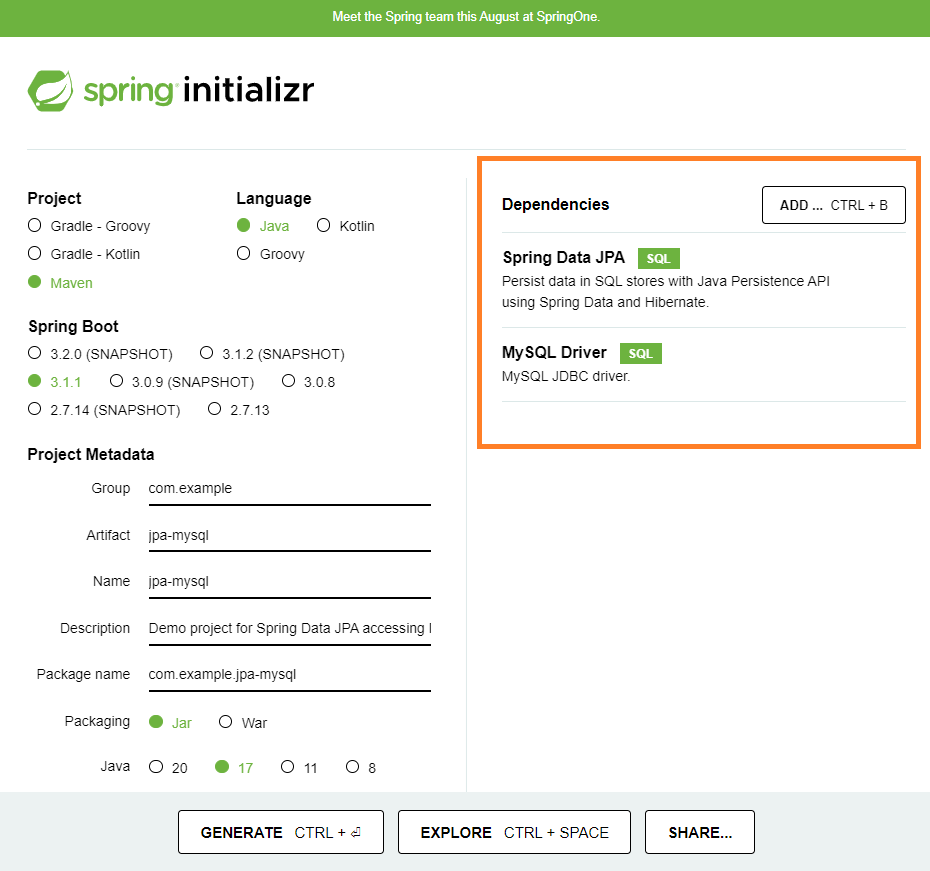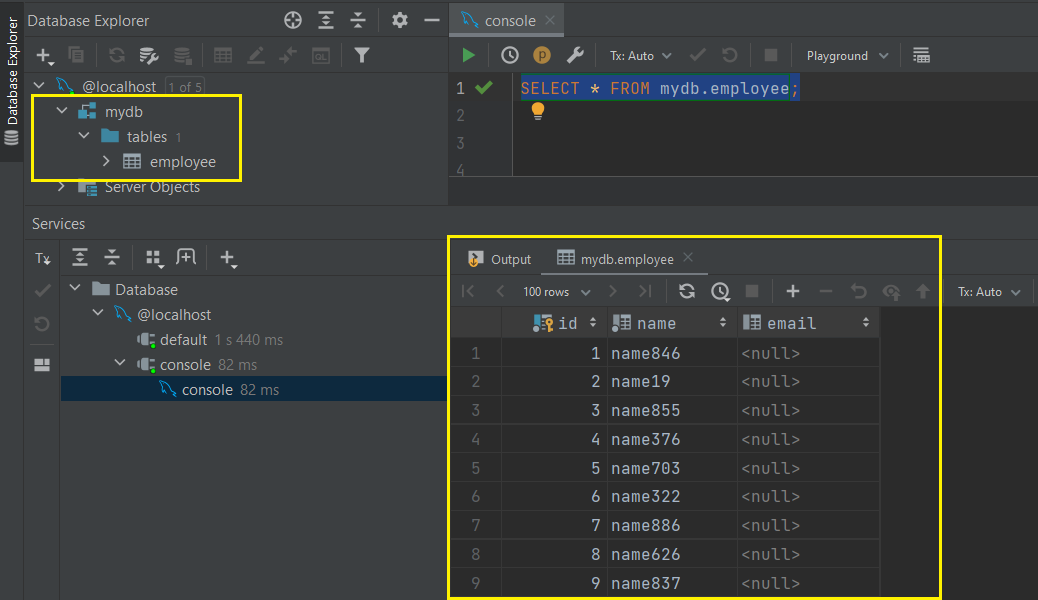#
Spring Data JPA : MySql database - Paginating the result
This tutorial explains how we can use Spring Data JPA with a MySql database and how to paginate the result of the query.
#
Install the MySql database
In my case I will install MySql database as a Docker container. In my case I am using Docker Desktop.
You need to run the docker pull mysql command in order to get the MySql image from docker.io.
C:\Users\Catalin>docker pull mysql
Using default tag: latest
latest: Pulling from library/mysql
e2c03c89dcad: Pull complete
68eb43837bf8: Pull complete
796892ddf5ac: Pull complete
6bca45eb31e1: Pull complete
ebb53bc0dcca: Pull complete
2e2c6bdc7a40: Pull complete
6f27b5c76970: Pull complete
438533a24810: Pull complete
e5bdf19985e0: Pull complete
667fa148337b: Pull complete
5baa702110e4: Pull complete
Digest: sha256:232936eb036d444045da2b87a90d48241c60b68b376caf509051cb6cffea6fdc
Status: Downloaded newer image for mysql:latest
docker.io/library/mysql:latestYou need to run the docker run --name my-mysql -p 3306:3306 -e MYSQL_ROOT_PASSWORD=p -d mysql command in order to create the mysql
container containing a MyQql instance in it. The container port 3306 will be exposed on the host side with the same port number.
C:\Users\Catalin>docker run --name my-mysql -p 3306:3306 -e MYSQL_ROOT_PASSWORD=p -d mysql
74d074e24c50bba5ced5e52c0cfab1006903d87be36a406fe1e1f075efe450f7For this example, I installed a trial version of DataGrip (MySql admin client).
With this admin tool I create a MySql database schema named "mydb" and a table "employees" as in the picture below:

Here is the code for creating the table:
create table employee
(
id int auto_increment
primary key,
name text not null,
email text null
);
#
Create the Spring Boot application
Now, let's create the Spring Boot application using Spring Data JPA.
First of all I will create a simple Spring Boot application using spring initializr
as in the image below:

In pom.xml we can see the following dependencies:
<dependency>
<groupId>org.springframework.boot</groupId>
<artifactId>spring-boot-starter-data-jpa</artifactId>
</dependency>
<dependency>
<groupId>com.mysql</groupId>
<artifactId>mysql-connector-j</artifactId>
<scope>runtime</scope>
</dependency>Now we can create an entity class:
package com.example.jpamysql.entity;
import jakarta.persistence.Column;
import jakarta.persistence.Entity;
import jakarta.persistence.Id;
@Entity
public class Employee {
public Employee() { }
public Employee(int id, String name, String email) {
this.id = id;
this.name = name;
this.email = email;
}
@Id
@Column(name = "id")
Integer id;
@Column(name = "name")
String name;
String email;
public int getId() {
return id;
}
public void setId(int id) {
this.id = id;
}
public String getName() {
return name;
}
public void setName(String name) {
this.name = name;
}
public String getEmail() {
return email;
}
public void setEmail(String email) {
this.email = email;
}
}Info
- The entity class must have
@Idannotation for underlying the column in the database which is the primary key. - We mark also the class with
@Entityannotation for telling that this is an entity in a database. - This class must have a default constructor.
Now, let's configure the DataSource:
package com.example.jpamysql;
import org.springframework.context.annotation.Bean;
import org.springframework.context.annotation.Configuration;
import org.springframework.jdbc.datasource.DriverManagerDataSource;
@Configuration
public class ConfigApp {
@Bean
public DriverManagerDataSource dataSource() {
DriverManagerDataSource dataSource = new DriverManagerDataSource();
dataSource.setDriverClassName("com.mysql.cj.jdbc.Driver");
dataSource.setUsername("root");
dataSource.setPassword("p");
dataSource.setUrl("jdbc:mysql://localhost:3306/mydb");
return dataSource;
}
}Now let's configure the EmployeeRepository interface. This interface is specific to Spring Data.
When we configure this interface, the needed classes/methods are autogenerated.
package com.example.jpamysql.interfaces;
import com.example.jpamysql.entity.Employee;
import org.springframework.data.jpa.repository.JpaRepository;
import org.springframework.stereotype.Repository;
@Repository
public interface EmployeeRepository extends JpaRepository<Employee, Integer> {}package com.example.jpamysql;
import com.example.jpamysql.entity.Employee;
import com.example.jpamysql.interfaces.EmployeeRepository;
import org.springframework.boot.SpringApplication;
import org.springframework.boot.autoconfigure.SpringBootApplication;
import org.springframework.context.ApplicationContext;
import org.springframework.data.domain.PageRequest;
import org.springframework.data.domain.Pageable;
import java.util.ArrayList;
import java.util.List;
@SpringBootApplication
public class JpaMysqlApplication {
public static void main(String[] args) {
ApplicationContext context = SpringApplication.run(JpaMysqlApplication.class, args);
List<Employee> empList = new ArrayList<>();
for (int i = 1; i <= 100; ++i) {
empList.add(new Employee(i, "name"+1*Math.round(Math.random()*1000), null ));
}
EmployeeRepository eRepository = context.getBean(EmployeeRepository.class);
// The "deleteAll" method is auto-generated
eRepository.deleteAll();
// The "saveAll" method is auto-generated
eRepository.saveAll(empList);
// Define the way we want to paginate the result
Pageable firstPageWithTenElements = PageRequest.of(0, 10);
// The "findAll" method is auto-generated.
Iterable<Employee> employeesResult = eRepository.findAll(firstPageWithTenElements);
employeesResult.forEach(emp -> {
System.out.println("Emp Name = "+emp.getName()+", Emp Id="+emp.getId());
});
}
}Info
- Please take a look at the comment above in order to understand how Spring Data is working.
EmployeeRepositorycould extendsCrudRepository,PagingAndSortingRepositoryorJpaRepository. CrudRepository defines the CRUD methods. PagingAndSortingRepository defines methods for pagination and sorting (extends CrudRepository). JpaRepository provides some JPA-related methods such as flushing the persistence context and deleting records in a batch (extends PagingAndSortingRepository).
When we run the application we can see in the database the following data:

The console will show us the something like this:
Emp Name = name634, Emp Id=1
Emp Name = name195, Emp Id=2
Emp Name = name890, Emp Id=3
Emp Name = name781, Emp Id=4
Emp Name = name375, Emp Id=5
Emp Name = name655, Emp Id=6
Emp Name = name405, Emp Id=7
Emp Name = name542, Emp Id=8
Emp Name = name41, Emp Id=9
Emp Name = name441, Emp Id=10
